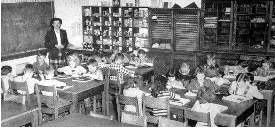
VOL. 23, No. 3, 117 - 132
When technology is used in reference to education today, the term is most often thought of as being synonymous with computers. In the past, however, the term educational technology also included other apparatus, either to disseminate information in a classroom, e.g., the overhead projector, or to transmit information some distance, such as with radio or television (Benenson, 2000; Saettler, 1990). While the importance of computers both in education and in everyday life is indisputable, computers were not the first, nor are they likely to be the last technology that promises to alter educational practice. One example of how the promise of an earlier distance learning technology changed at least an aspect of education is found in Alberta teacher education of the 1960s.
De nos jours, lorsque le terme technologie est employé en lien avec l’éducation, celui-ci évoque presque toujours les ordinateurs. Par le passé, toutefois, le terme technologie éducative incluait également d’autres appareils, soit pour diffuser l’information dans une salle de classe, par exemple, le rétroprojecteur, ou pour transmettre de l’information sur une certaine distance, comme c’est le cas avec la radio ou la télévision (Benenson, 2000; Saettler, 1990). Alors que l’importance des ordinateurs dans le cadre de l’éducation et de la vie quotidienne est incontestable, les ordinateurs n’ont pas été la première, ni, selon toute probabilité, seront-ils la dernière technologie qui vienne modifier les pratiques de l’enseignement. Un exemple de comment la promesse d’une technologie d’apprentissage antérieure a modifié au moins un volet de l’éducation se trouve dans l’éducation des enseignants de l’Alberta pendant les années soixante.
Although the Province of Alberta had begun to transfer teacher preparation from the normal schools to the University of Alberta during the 1930s, the university did not assume full responsibility for teacher preparation until the closure of the last normal school in 1945. The shift from normal school to university did not alter the basic structure of teacher preparation appreciably.
Since their inception, Alberta's normal schools possessed demonstration schools (sometimes referred to as experimental or laboratory schools) as an integral part of their teacher preparation program and infrastructure (Alberta Department of Education, 1905-1915). In most places, and Alberta was no exception, demonstration schools offered regular instruction to school-age students who lived in the vicinity. Such schools were commonplace in North American teacher education centres during the 19th century (McGeoch, 1971; Page & Page, 1981). In describing the reason why such schools were established in conjunction with centres of teacher education, McGeoch (1971) states that demonstration schools, “provided a place in which prospective teachers could observe and practice prevailing methods of teaching” (p. 1). This was an important consideration at a time when there were few schools in the vicinity of the teacher education institution, and usually, most of those were in urban areas. Rural experiences in teacher education were difficult to come by. Poor roads and slow modes of transportation meant that most rural schools were not easily accessible by pre-service teachers.
As teacher education institutions evolved or were subsumed by universities, an increasing interest in research arose. The demonstration school was seen by many to be the natural and ideal setting for conducting experiments in, among other things, curriculum, pedagogical method and teacher education approaches (Page & Page, 1981). At the University of Alberta, some professors did indeed use the demonstration school for experimental purposes. For example, the first Dean of the Faculty of Education, M. E. LaZerte, developed a method of instructing arithmetic that used practical concrete examples. To test his ideas, LaZerte adapted a seemingly ordinary classroom in the demonstration school, as shown in Figure 1, so that it could be re-configured in short order as a mock store, as shown in Figure 2 (LaZerte, 1953).

Figure 1. A classroom in the University of
Alberta's demonstration school
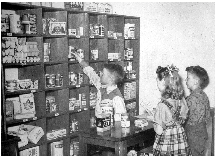
Figure 2. Classroom adapted
to serve as a mock store
In the years following the Second World War, enrolments in the Faculty of Education rose steadily. The post-war economic improvement led to the closure and replacement of small one-room and two-room schools, with large multi-room schools located in centres of population. At the same time, roads were improved, and more people than ever before could afford automobiles. It was, therefore, practical for students to obtain more classroom experience in off-campus schools, rather than in the somewhat contrived atmosphere of the demonstration schools.
By the mid 1950s, enrolment in the University of Alberta's teacher education programs became so large that the old normal school building proved inadequate for the numbers. Coincidentally, television as an entertainment and educational medium had also burgeoned, with some schools in Canada already using television for instructional purposes (Morton, 1959; Lambert, 1962). With the need for a larger building, and with increased funding from several levels of government, the Faculty of Education at the University of Alberta was in a position to have a new building constructed.
Although there was adequate funding for a new building, considerable care in the design was necessary to avoid cost overruns, or creating an unsuitable structure. The latter consideration remained uppermost in the minds of the planning committee, since the building was anticipated to last in excess of 50 years. To optimize the design of the new building, Dean Herbert T. Coutts and his building planning committee examined all aspects of what had occurred in teacher preparation previously in Alberta. Additionally, buildings and practices at other teacher education institutions in North America were examined. One of the most expensive attributes of the existing program at the University of Alberta was the demonstration school. As research was, and is, an important part of a university, the question of whether or not to continue the demonstration school arose. Data from studies that examined the purposes and utility of other demonstration schools in North America helped reveal what demonstration schools were being used for.
As early as 1930, a study of American normal schools and teacher colleges found that over 95% of institutions used demonstration schools solely for aspects of student teaching, rather than for research or experimentation (Williams, 1930). A study conducted in 1952 found that the majority of demonstration schools did not engage in any research activities (Rucker, 1952). Kelly (1964) reported similar results, finding that of the 212 college or university controlled laboratory or demonstration schools in the United States, most were used primarily to enable students to observe teaching. Approximately 13% of the institutions indicated that either research or experimentation comprised the major activities carried out. From such data, and from direct observation by Coutts and his committee, it seemed clear that most demonstration schools were not functioning as research venues.
The Faculty of Education's demonstration school occupied much space in the old normal school. To accommodate a demonstration school in the new building would require a large area. This meant that there might not be enough space in the new building for other facilities. Another consideration was that classes in the demonstration school had to be taught even at times when the regular university sessions were over. Not only was this expensive, but it was also unpopular with many staff, especially new professors who did not come from a normal school background (personal communication with Dr. S.M. Hunka, April, 2002). Most importantly, it appeared that little research entailing experimental teaching methods was being conducted by professors (Coutts, 1982b). Nevertheless, Coutts and the building committee maintained that it was necessary for pre-service teachers to observe model lessons with age-appropriate students.
To address these concerns, but at the same time continue to offer the advantages of the demonstration school, a seemingly cost-effective alternative was considered, television technology. As early as 1932, George Cutten, President of Colgate University, predicted that in a few years, television would enable the university classroom to extend to the world (Cutten, 1932). Given the development of commercial television during the 1950s, there was considerable support for the belief that television, besides being a medium of entertainment, had the potential to transform education for the better (Carpenter & Greenhill, 1958; Campion & Kelley, 1963). Additionally, since the late 1940s, both commercial and strictly educational television stations had been used to disseminate instructional material to schools, including lessons provided by famous individuals who usually would otherwise be unavailable to most schools (Saettler, 1990; Cuban, 1986).
Coincidentally with the rise of commercial and educational television, some educators considered its applications to teacher preparation. Largely through funding provided by the National Defense Education Act of the United States, starting in 1958, several American universities undertook the study of television for pre-service teacher education (Schueler, Gold & Mitzel, 1962). Among the projects were two that used television to provide pre-service teachers at a central location the means to observe activities at remote schools. In one study, Michigan State University devised a mobile television facility in a truck trailer that was transported to schools. Cameras were set up in particular classrooms, and lessons were either beamed directly to the university, or were recorded on kinescope (Schueler, et al., 1962). A “kinescope” was an early video recording technology, predating videotape, which entailed a film motion picture camera placed in front of a Cathode Ray Tube (CRT) television. The film would record what was shown on the television (O'Dell, n.d.). Playback was possible when the film was processed and then projected using conventional film projection equipment, or was rebroadcast using television cameras to capture the images. The other experimental effort of note was at Hunter College in New York City. Hunter College possessed an experimental school, and researchers were interested in ascertaining whether instruction to pre-service teachers was affected either by the use of closed circuit television transmissions of lessons, or lessons presented via kinescope (Schueler, et al., 1962). Both the Michigan and New York studies, aimed to find out whether using television as a distance learning tool in this manner was an effective instructional medium, and how it compared with face-to-face instruction and experiences.
There were technical problems reported with initial trials. As early video cameras lacked the sensitivity of modern equipment, supplementary lighting was required. Additionally, sound quality was poor because of echoes. Cables necessary to power and to connect the video cameras to the kinescope and control equipment posed a tripping hazard. These problems were solved by installing acoustical tiles on the ceilings and walls and carpeting in the classrooms where the cameras would be used. Apart from sound deadening, the carpeting had the added benefit of covering the cables (Schueler, et al., 1962). It was reported that because of the length of film that kinescope machines could hold, only 25 minutes of a lesson could be captured. As well, the processing required for kinescope films meant that there was a delay of up to several days between the live lesson and remote viewing (Schueler, et al., 1962). Such limitations and delays were not present in the live closed circuit transmissions.
In the Hunter College study, experimental designs were used, where students were grouped and compared according to the type of instruction received: direct observation only; observation via closed circuit television; observation via kinescope; or various combinations of direct observation and television technologies. Interviews with the pre-service teachers were also conducted to provide some qualitative data (Schueler, et al., 1962). The findings revealed that there was no significant difference in effectiveness between the methods used. It was noted, however, that some students did not like the kinescope approach. Main reasons cited included: mechanical problems; poor sound and image quality; possible changing of emphasis and meaning through editing the kinescope (Schueler, et al., 1962). The most common complaint, though, was the poor quality of the kinescopes, a phenomenon noted about kinescopes in general (O'Dell, n.d.). It was reported that some pre-service teachers contended that with the kinescope alone, the real feeling of the classroom was not conveyed. However, if the instructor was present, that criticism was not reported (Schueler, et al., 1962, pp. 95-96).
A follow up study addressed some of the technological issues. While kinescopes continued to be used initially, it was reported that videotapes were of better quality, and these were recommended instead of kinescopes. Additionally, it had been found that with the closed circuit distribution of live images, the usual method of data transmission by means of telephone lines, was inferior (Stoller & Lesser, 1963). Instead, it was found that connecting televisions with control rooms via coaxial cable markedly improved image and sound quality. Another technological improvement was the addition of a two-way intercom system between viewing classrooms and the location where the lessons were occurring. Although the Hunter College experiments were ongoing, and the video technology used was also changing, the University of Alberta's Faculty of Education building committee considered the findings solid enough to proceed with their own installation. Moreover, with the noted improvement of quality between videotape and kinescope, there was an impression that by the time any installation was operational in the Faculty of Education, the technology would be even better (Personal communications with Dr. H.T. Coutts, August 1992).
Additionally, a small experiment with closed-circuit television, linking school classrooms to television sets at the University of Alberta had been conducted in the Faculty of Education during 1958, and was considered successful (Morton, 1959). To many educators, it seemed that television technology had the potential to effect positive change to many aspects of education, even resulting in the realization of Cutten's prediction made 30 years previously (Cutten, 1932). Coutts and the building committee proposed to replace the demonstration school with a state-of-the-art television installation that would permit pre-service teachers to remain in the education building while being able to observe specific procedures and lessons in nearby schools via closed circuit television. In this manner, the new education building could dispense with a demonstration school. Instead of a low-rise building that would occupy a large area, the new building could occupy a smaller space. While classrooms would flank professors' offices, it was also proposed to make the central portion of the building a high-rise tower that could also serve as a convenient means of receiving television signals. It was not possible both to construct a new demonstration school and to equip the new building with television technology. The budget permitted only one or the other. Besides the expense of equipment, individuals skilled in the production of television programs, and the maintenance of equipment were required (Personal communications with Dr. H.T. Coutts, August 1992).
Rather than adopting either the system described in the Hunter College study, or the mobile truck arrangement used by Michigan State, a combination of the two approaches was used at the University of Alberta. It was thought that by employing a truck with a camera crew and a mobile closed-circuit transmitter, particular lessons or events at schools in the surrounding area could be beamed to the new education building. Once received by an antenna on the top of the building, the signal would be transformed to usable analogue frequencies, and then distributed via coaxial cable to many of the building's classrooms, where students could watch the proceedings on large-screen television sets (Coutts, 1982a; 1982b).
In spite of spirited opposition, primarily by older staff who came from the normal schools, the Faculty of Education decided to adopt television technology as a replacement for the demonstration school. Construction of the new education building began in 1962, and was completed in 1964. Figure 3 shows the appearance of the education building in 1965. The four-story classroom wings flank the tower. The tower housed staff offices primarily as well as meeting rooms and technical facilities.
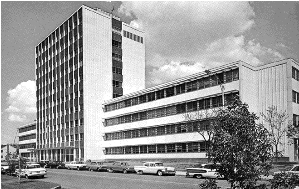
Figure 3. The education building in 1965
When constructed, the education building was equipped with a network of coaxial cables that ran to each classroom through the walls. A special room in the tower served as the video head end, where incoming signals were converted to useable frequencies, and then distributed to select classrooms via a switchboard connected to the coaxial cables. A dedicated operator controlled the operation of the head end. Large-screen television sets mounted on wheeled carts were used in the classrooms. It should be noted that at the time, only CRT televisions, with vacuum tube amplifiers were available. In consequence, large diameter televisions tended to be extremely heavy. Although colour television had existed in one form or another since the 1920s (Dinsdale, 1932), the commercial technology available in the early 1960s could accommodate only black and white signals. Figure 4 shows one of the first television sets as mounted on a wheeled cart. The vertical object below the television, towards the left-hand side of the cart, is the speaker.
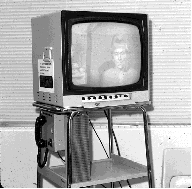
Figure 4. Television set,
wheeled cart and handset
Initially, only live transmissions were used. Television cameras were transported to and from schools with the aid of a large panel truck. The truck also housed a low-power microwave transmitter and power supply. A small directional antenna mounted on the roof of the truck, beamed signals to an antenna array located on the roof of the education building tower. As the television signal from the truck traveled along “line of sight”, it was necessary to have an unobstructed path between the truck and the education building to ensure a useable signal (Personal Communication with Dr. S.M. Hunka, June 2006).
As the camera operators were often not familiar with what the instructor in the education building wanted the class to see, a half-duplex radio system (operated similar to a walkie-talkie or CB radio) permitted communication between the instructor and the camera crew. A telephone-like handset was attached to each television cart (see Figure 4). A separate coaxial cable connected the handset to a transceiver and antenna, located in the head end and roof respectively. In operation, the instructor would tell the camera crew where to point the camera, and when and where to reposition the frame (Personal communications with Dr. H.T. Coutts, August 1992; Personal Communications with Dr. S.M. Hunka, September 2006).
While the idea and plan appeared logical, the technology delivered less than it promised. From the outset, sound quality was abysmal. Ambient sounds such as fans were invariably overpowering, while the voices of specific children often could not be heard (Coutts, 1982a). Additionally, if a pencil fell from a desktop to the floor, it sounded like a rifle shot on the television set (Personal communications with Dr. H.T. Coutts, August 1992). Picture quality was often affected adversely by aircraft passing overhead. This proved to be a chronic problem, as the education building was directly beneath a flight path into the Edmonton Municipal Airport. The advantage of remotely placed cameras proved to be limited. Schools to the north of the education building could not be used, since there were several tall buildings between the schools and the education building. The buildings either blocked the transmitted signal completely, or they interfered with it sufficiently to create severe image ghosting. In either case, the picture and sound quality was unsatisfactory (Coutts, 1982b; Personal communications with Dr. H.T. Coutts, August 1992).
The presence of the television cameras in school classrooms was often distracting to the students, and in some classrooms, additional lighting was required. The extra lights often elevated the temperature in the school classroom to intolerable levels (Personal communications with Dr. H.T. Coutts, August 1992). Since there was considerable delay between events occurring and an instructor issuing appropriate commands to the camera crew, all too often critical events in classes were missed (Coutts, 1982a).
Problems also occurred with the equipment in the education building. As there were few sets, instructors had to book them well in advance, and the sets had to be moved from room to room. This motion often contributed to problems with the sets, resulting in ongoing maintenance. Many instructors expressed frustration at having to change planned activities at the last moment because a television set malfunctioned. Although the coaxial cable network functioned reasonably well initially, the cables themselves could be damaged easily. By placing the cables within the walls when the education building was constructed, it was believed that the cables would be protected adequately. Problems occurred when modifications were made to the building that entailed either drilling into walls, or otherwise altering structural components. Additionally, mice had infiltrated parts of the building via underground conduits, and several coaxial cables were damaged by gnawing (Personal communications with Dr. H.T. Coutts, August 1992). By 1966, just two years after the system began, television sets could not be used in several classrooms, either because the signal quality was so poor as the result of cable damage, or because there was no signal reaching the classroom at all (Coutts, 1982a; Coutts, 1982b; Personal communications with Dr. H.T. Coutts, August 1992).
There were attempts made to rectify problems as they appeared. To preserve transmissions for additional viewing, a reel-to-reel video tape recorder was obtained for the head end. Figure 5 shows the first video tape recorder, a one-inch reel-to-reel recorder that could record up to one hour of video per tape.
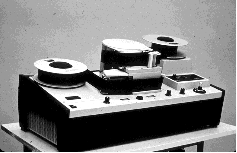
Figure 5. Reel-to-reel video tape recorder
In spite of several modifications to equipment, transmission frequencies and antennae, there was little improvement either to the quality of the pickup, or to the signal quality from schools. As the overall quality remained inferior, university instructors began to abandon the system (Personal communications with Dr. H.T. Coutts, August 1992).
Another attempt at improving the system entailed installing a video tape recorder in the truck, and employing education graduate students as camera operators. It was thought that since graduate students were usually teachers, they would be better prepared to focus cameras on “teachable moments” than camera operators. Lessons were then taped at the schools, and the tapes brought back to the education building for subsequent distribution via another player and the coaxial cable network. While this modification resulted in improved picture quality, often what was recorded was not immediately useful in class, as considerable editing was necessary. Most professors and graduate students complained that they had neither the time nor the skill to do this (Personal communications with Dr. H.T. Coutts, August 1992). By 1968, the use of the truck and remote recording/transmitting ceased. The truck languished at the west side of the education building, before being disposed of in the early 1970s (Personal communications with Dr. H.T. Coutts, August 1992; Information from Dr. S.M. Hunka, 2006).
After the demise of the truck, another modification was the construction of a small television studio out of two existing classrooms in the west wing of the education building. By transporting students in from schools, lessons or particular scenarios could be recorded in a studio with proper sound and lighting properties. While this modification resulted in a marked improvement in overall quality, it proved difficult to get students from schools and into the studio, especially when entire classes were required. Moreover, some schools objected to the disruption and loss of instructional time that this arrangement entailed (Personal communications with Dr. H.T. Coutts, August 1992).
Improvements in television technology were incorporated into the system as they became available, although its use continued to decrease. The original cart-mounted television sets were replaced by televisions that were attached to ceiling mounted supports, placed near the front of the classroom. The new televisions received mixed reviews. Although the need to book and move television sets around was largely dispensed with, the fixed placement of the televisions proved problematic. While some adjustment of the position was possible, often students at the rear of the classroom could not see the picture clearly.
Although many modifications occurred, and several attempts were made to preserve the demonstrational aspects of the old demonstration school, the consensus was that the television installation proved to be a poor substitute. A convenient means of permitting pre-service teachers opportunities for observation and even student teaching had been lost, as well as easy access to school-age classes by professors and pre-service teachers. Apart from a few individual projects, general use of the television system ceased in 1970 (Coutts, 1982a; 1982b).
The decision to adopt television technology, at the expense of the demonstration school had far reaching consequences. In spite of the Hunter College and Michigan State studies, little long-term research had been undertaken regarding the feasibility of such approaches (Levy, 2004). The education building had not been configured for a demonstration school, and the design of the building precluded the later addition of such a school. In practice, it quickly became apparent that the technology was disappointing and ineffective. At best, it provided a view of specific classes, one step removed from being there. At worst, nothing was provided.
Although one of the reasons for dispensing with the demonstration school was expense, the cost of operating, maintaining and upgrading the television equipment also proved to be more expensive than anticipated. Moreover, the personnel required to operate and maintain the system were also costly (Personal communications with Dr. H.T. Coutts, August 1992).
Not all of the consequences resulting from the demise of the demonstration school and the subsequent distance television installation were negative. The loss of the demonstration school led to a shift in professors' workload. Instead of teaching university courses as well as scholastic courses, teaching loads were reduced simply to university courses. Teaching duties and loads became more in line with those of other faculties in the university.
While the change in workload may be considered a positive outcome of the elimination of the demonstration school, the failure of the television technology to deliver quality video meant that not only was the venture unsuccessful, but some professors would regard subsequent technological developments applied to education with skepticism. While initiatives continue to bring school-age students to campus either for observation by pre-service teachers, or to participate in experimental methods of pedagogy, the general exposure of pre-service teachers to off-campus school students through distance technology, however, has never reoccurred at the University of Alberta. Since the 1960s, however, video technology has changed markedly. Now in the era of digital video, Skype, and small computer-based cameras, it may be possible to achieve the goal of observing remote model classes without severe technological limitations. So far, however, the use of digital video conferencing technology to recreate the experiences envisaged by Coutts and his building planning committee has not materialized. As for the use of television in teacher education, television continues to be used both at the University of Alberta and elsewhere as a means of enabling pre-service teachers to record practice lessons and then review their performance (Brophy, 2004).
For better or worse, the decision to adopt television in place of a demonstration school altered both the architecture of the education building, as well as the operation of most teacher preparation programs at the University of Alberta, from 1964 on. While the experience of the Faculty of Education in the early 1960s should not be considered as a reason either to eschew new distance learning technologies, or to regard them dubiously, the experience should be regarded as an example of what can happen without adequate investigation and over-confidence in the capabilities of an emerging technology. As Rainsberry (1964) warned, “The gadget is born as a slave, but in all too many instances it quickly becomes the master…” (p. 8).
Alberta Department of Education. (1905-1915). Annual reports. Edmonton, AB: King's printer.
Benenson, G. (2000). The unrealized potential of everyday technology as a context for learning. Journal of Research in Science Teaching, 38(7) 730-745.
Brophy, J. (Ed). (2004). Using video in teacher education. New York, NY: Elsevier.
Campion, L.E., & Kelley, C.Y. (1963). Studies in the growth of instructional technology II: A directory of closed-circuit television installations in American education with a pattern of growth. Washington, DC: National Education Association.
Carpenter, C.R., & Greenhill, L.P. (1958). Instructional television research, report number 2: An investigation of closed-circuit television for teaching university courses. University Park, PA: The Pennsylvania State University.
Coutts, H.T. (1982a). The unfinished journey of Herbert T. "Pete" Coutts. Edmonton, AB: Unpublished manuscript.
Coutts, H.T. (1982b). The demonstration school question. In H.W. Hodysh, & R.G. McIntosh, Conversation with a Dean: The life and times of H.T. Coutts, Challenge in educational administration/The CSA Bulletin, 21(4) 97-98.
Cuban, L. (1986). Teachers and machines: The classroom use of technology since 1920. New York, NY: Teachers College, Columbia University.
Cutten, G.B. (1932). Epilogue. In O.E. Dunlap, Jr., The outlook for television. New York, NY: Harper & Brothers Publishers.
Kelly, E.H. (1964). College-controlled laboratory schools in the United States. Washington, DC: American Association of Colleges for Teacher Education.
Lambert, R.S. (1962). School broadcasting in Canada. Toronto, ON: University of Toronto Press.
LaZerte, M.E. (1953). Numbers tell their story. Toronto, ON: Clarke, Irwin & Company Limited.
McGeoch, D.M. (1971). The campus laboratory school: Phoenix or Dodo bird. ERIC Document ED050046
Morton, R.A. (1959). Educational television. Canadian Education, 14(2) 36-48.
O'Dell, C. (n.d.). Kinescope. The Museum of Broacast Communication. Available from:
http://www.museum.tv/archives/etv/K/htmlK/kinescope/kinescope.htm
Page, F.M., & Page, J.A. (1981). Laboratory schools: Updated or outdated. ERIC document ED213672.
Rainsberry, F.B. (1964). The CBC philosophy of educational broadcasting. Teaching Aids News, 4(22) 6-8.
Rucker, W.R. (1952). A critical analysis of current trends in student teaching. Unpublished doctoral dissertation, Harvard University, Cambridge, MA.
Saettler, P. (1990). The evolution of American educational technology. Englewood, CO: Libraries Unlimited, Inc.
Schueler, H.G., Gold, M.J., & Mitzel, H.E. (1962). The use of television in teacher training and for improving measures of student teaching performance, Phase I: Improvement of student teaching. New York, NY: Hunter College.
Williams, E.I. (1930). The actual and potential use of laboratory schools in state normal schools and colleges: Contributions to education, No. 846. New York, NY: Teachers College, Columbia University.
George H. Buck is an Associate Professor in the Department of Educational Psychology, University of Alberta and has been involved with the study and use of instructional technology and distance learning technologies for many years. E-mail: george.buck@ualberta.ca